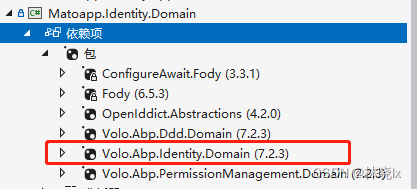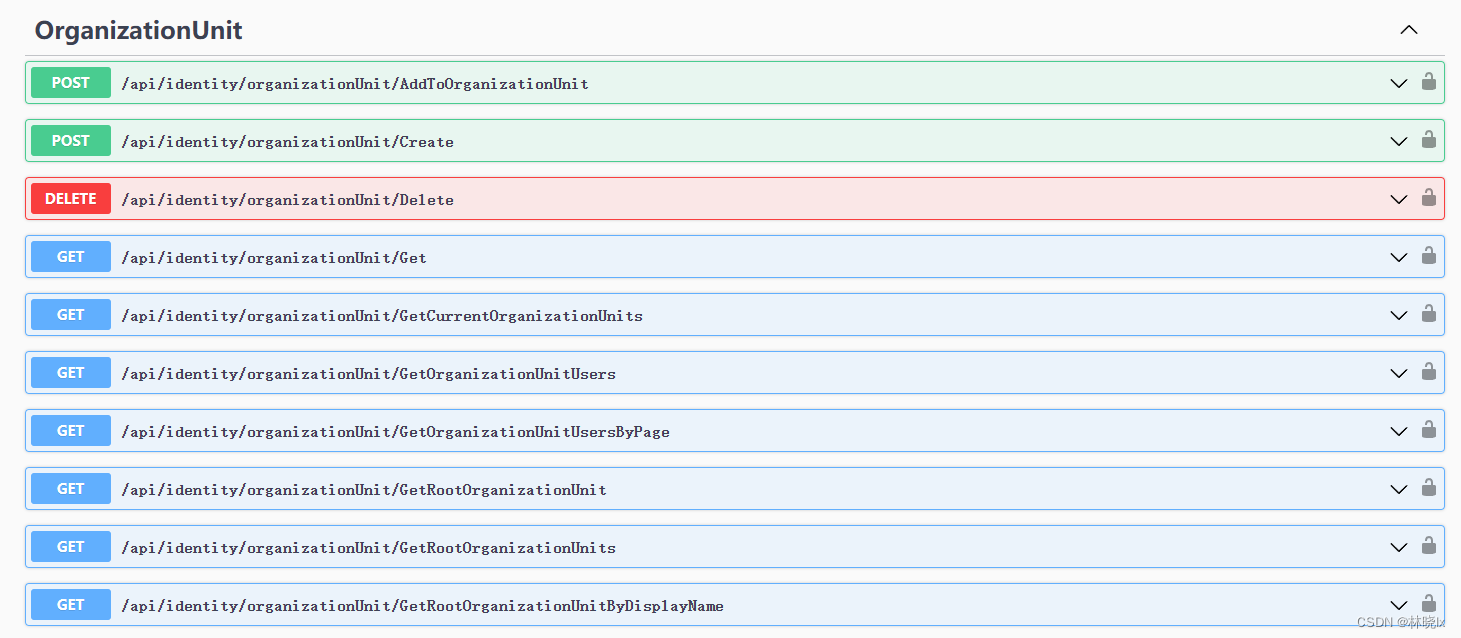怎樣優雅地增刪查改(二):擴充套件身份管理模組
@
身份管理模組(Identity模組)為通用查詢介面的按組織架構查詢和按戶關係查詢提供查詢依據。
身份管理模組的領域層依賴Volo.Abp.Identity.Domain

Abp為我們實現了一套身份管理模組,此模組包含使用者管理、角色管理、組織管理、許可權管理等功能。詳細請參考身份管理模組。
我們將基於Volo.Abp.Identity模組按需求擴充套件。將為其擴充套件組織管理功能的介面,以及人員關係(Relation)功能。
使用者關係管理
Relation是人員之間的關係,比如:簽約、關注,或者朋友關係等。人員之間的關係是單項的,也就是說可以A是B的好友,但B不一定是A的好友。
關係型別由Type來定義
正向關係:User -> RelatedUser,由查詢GetRelatedToUsersAsync實現;
反向關係:RelatedUser -> User,由查詢GetRelatedFromUsersAsync實現。
新增Relation實體:
public class Relation : FullAuditedAggregateRoot<long>
{
public Guid? TenantId { get; set; }
[Key, DatabaseGenerated(DatabaseGeneratedOption.Identity)]
public override long Id { get; protected set; }
public Guid UserId { get; set; }
[ForeignKey("UserId")]
public IdentityUser User { get; set; }
public Guid RelatedUserId { get; set; }
[ForeignKey("RelatedUserId")]
public IdentityUser RelatedUser { get; set; }
public string Type { get; set; }
}
在模組設定中新增
public class IdentityEntityFrameworkCoreModule : AbpModule
{
public override void ConfigureServices(ServiceConfigurationContext context)
{
context.Services.AddAbpDbContext<IdentityDbContext>(options =>
{
options.AddRepository<IdentityUserOrganizationUnit, EfCoreRepository<IdentityDbContext, IdentityUserOrganizationUnit>>();
options.AddRepository<Relation.Relation, EfCoreRepository<IdentityDbContext, Relation.Relation>>();
});
}
}
建立RelationManager,實現人員關係的正向和反向查詢
public async Task<List<Relation>> GetRelatedToUsersAsync(Guid userId, string type)
{
var query = (await Repository.GetQueryableAsync())
.WhereIf(userId != null, c => userId == c.UserId)
.WhereIf(!string.IsNullOrEmpty(type), c => c.Type == type);
var items = query.ToList();
return items;
}
public async Task<List<Relation>> GetRelatedFromUsersAsync(Guid userId, string type)
{
var query = (await Repository.GetQueryableAsync())
.Where(c => userId == c.RelatedUserId)
.WhereIf(!string.IsNullOrEmpty(type), c => c.Type == type);
var items = query.ToList();
return items;
}
擴充套件組織管理功能
組織(OrganizationUnit)是身份管理模組的核心概念,組織是樹形結構,組織之間存在父子關係。
我們對功能模組的介面進行擴充套件:
-
增加OrganizationUnit的增刪查改介面;
-
增加OrganizationUnit的移動介面;
-
增加人員與組織架構管理介面,如新增/刪除人員到組織架構,查詢組織架構下的人員,查詢未分配組織的人員等;
-
增加查詢根組織(GetRootOrganizationUnit)介面。
完整的應用層介面如下:
public interface IOrganizationUnitAppService : IBasicCurdAppService<OrganizationUnitDto, Guid, CreateOrganizationUnitInput, UpdateOrganizationUnitInput>, IApplicationService
{
Task AddToOrganizationUnitAsync(UserToOrganizationUnitInput input);
Task<List<OrganizationUnitDto>> GetCurrentOrganizationUnitsAsync();
Task<PagedResultDto<IdentityUserDto>> GetOrganizationUnitUsersByPageAsync(GetOrganizationUnitUsersInput input);
Task<List<IdentityUserDto>> GetOrganizationUnitUsersAsync(GetOrganizationUnitUsersInput input);
Task<OrganizationUnitDto> GetRootOrganizationUnitAsync(Guid id);
Task<List<OrganizationUnitDto>> GetRootOrganizationUnitsAsync(IEnumerable<Guid> ids);
Task<OrganizationUnitDto> GetRootOrganizationUnitByDisplayNameAsync(GetRootOrganizationUnitByDisplayName input);
Task<List<OrganizationUnitDto>> GetRootOrganizationUnitsByParentAsync(GetRootOrganizationUnitsByParentInput input);
Task<bool> IsInOrganizationUnitAsync(UserToOrganizationUnitInput input);
Task MoveOrganizationUnitAsync(MoveOrganizationUnitInput input);
Task RemoveUserFromOrganizationUnitAsync(UserToOrganizationUnitInput input);
Task<List<IdentityUserDto>> GetUsersWithoutOrganizationAsync(GetUserWithoutOrganizationInput input);
Task<PagedResultDto<IdentityUserDto>> GetUsersWithoutOrganizationByPageAsync(GetUserWithoutOrganizationInput input);
}
建立可查詢倉儲
通用查詢介面過濾條件需要對IQueryable進行拼接,由於Volo.Abp.Identity.IIdentityUserRepository繼承自IBasicRepository,我們需要重新編寫一個IdentityUser的可查詢倉儲:QueryableIdentityUserRepository
其實現介面IQueryableIdentityUserRepository的定義如下:
public interface IQueryableIdentityUserRepository : IIdentityUserRepository
{
Task<IQueryable<OrganizationUnit>> GetOrganizationUnitsQueryableAsync(Guid id, bool includeDetails = false);
Task<IQueryable<IdentityUser>> GetOrganizationUnitUsersAsync(
Guid id, string keyword, string[] type,
bool includeDetails = false);
Task<IQueryable<IdentityUser>> GetUsersWithoutOrganizationAsync(string keyword, string[] type);
}
實現控制器
為OrganizationUnitAppService 以及 RelationAppService 建立MVC控制器
完整的 OrganizationUnitController 程式碼如下:
namespace Matoapp.Identity.OrganizationUnit
{
[Area(IdentityRemoteServiceConsts.ModuleName)]
[RemoteService(Name = IdentityRemoteServiceConsts.RemoteServiceName)]
[Route("api/identity/organizationUnit")]
public class OrganizationUnitController : IdentityController, IOrganizationUnitAppService
{
private readonly IOrganizationUnitAppService _organizationUnitAppService;
public OrganizationUnitController(IOrganizationUnitAppService organizationUnitAppService)
{
_organizationUnitAppService = organizationUnitAppService;
}
[HttpPost]
[Route("AddToOrganizationUnit")]
public async Task AddToOrganizationUnitAsync(UserToOrganizationUnitInput input)
{
await _organizationUnitAppService.AddToOrganizationUnitAsync(input);
}
[HttpPost]
[Route("Create")]
public async Task<OrganizationUnitDto> CreateAsync(CreateOrganizationUnitInput input)
{
return await _organizationUnitAppService.CreateAsync(input);
}
[HttpDelete]
[Route("Delete")]
public async Task DeleteAsync(Guid id)
{
await _organizationUnitAppService.DeleteAsync(id);
}
[HttpGet]
[Route("Get")]
public async Task<OrganizationUnitDto> GetAsync(Guid id)
{
return await _organizationUnitAppService.GetAsync(id);
}
[HttpGet]
[Route("GetCurrentOrganizationUnits")]
public async Task<List<OrganizationUnitDto>> GetCurrentOrganizationUnitsAsync()
{
return await _organizationUnitAppService.GetCurrentOrganizationUnitsAsync();
}
[HttpGet]
[Route("GetOrganizationUnitUsers")]
public async Task<List<IdentityUserDto>> GetOrganizationUnitUsersAsync(GetOrganizationUnitUsersInput input)
{
return await _organizationUnitAppService.GetOrganizationUnitUsersAsync(input);
}
[HttpGet]
[Route("GetOrganizationUnitUsersByPage")]
public async Task<PagedResultDto<IdentityUserDto>> GetOrganizationUnitUsersByPageAsync(GetOrganizationUnitUsersInput input)
{
return await _organizationUnitAppService.GetOrganizationUnitUsersByPageAsync(input);
}
[HttpGet]
[Route("GetRootOrganizationUnit")]
public async Task<OrganizationUnitDto> GetRootOrganizationUnitAsync(Guid id)
{
return await _organizationUnitAppService.GetRootOrganizationUnitAsync(id);
}
[HttpGet]
[Route("GetRootOrganizationUnits")]
public async Task<List<OrganizationUnitDto>> GetRootOrganizationUnitsAsync(IEnumerable<Guid> ids)
{
return await _organizationUnitAppService.GetRootOrganizationUnitsAsync(ids);
}
[HttpGet]
[Route("GetRootOrganizationUnitByDisplayName")]
public async Task<OrganizationUnitDto> GetRootOrganizationUnitByDisplayNameAsync(GetRootOrganizationUnitByDisplayName input)
{
return await _organizationUnitAppService.GetRootOrganizationUnitByDisplayNameAsync(input);
}
[HttpGet]
[Route("GetRootOrganizationUnitsByParent")]
public async Task<List<OrganizationUnitDto>> GetRootOrganizationUnitsByParentAsync(GetRootOrganizationUnitsByParentInput input)
{
return await _organizationUnitAppService.GetRootOrganizationUnitsByParentAsync(input);
}
[HttpGet]
[Route("GetUsersWithoutOrganization")]
public async Task<List<IdentityUserDto>> GetUsersWithoutOrganizationAsync(GetUserWithoutOrganizationInput input)
{
return await _organizationUnitAppService.GetUsersWithoutOrganizationAsync(input);
}
[HttpGet]
[Route("GetUsersWithoutOrganizationByPage")]
public async Task<PagedResultDto<IdentityUserDto>> GetUsersWithoutOrganizationByPageAsync(GetUserWithoutOrganizationInput input)
{
return await _organizationUnitAppService.GetUsersWithoutOrganizationByPageAsync(input);
}
[HttpGet]
[Route("IsInOrganizationUnit")]
public async Task<bool> IsInOrganizationUnitAsync(UserToOrganizationUnitInput input)
{
return await _organizationUnitAppService.IsInOrganizationUnitAsync(input);
}
[HttpPost]
[Route("MoveOrganizationUnit")]
public async Task MoveOrganizationUnitAsync(MoveOrganizationUnitInput input)
{
await _organizationUnitAppService.MoveOrganizationUnitAsync(input);
}
[HttpPost]
[Route("RemoveUserFromOrganizationUnit")]
public async Task RemoveUserFromOrganizationUnitAsync(UserToOrganizationUnitInput input)
{
await _organizationUnitAppService.RemoveUserFromOrganizationUnitAsync(input);
}
[HttpPut]
[Route("Update")]
public async Task<OrganizationUnitDto> UpdateAsync(UpdateOrganizationUnitInput input)
{
return await _organizationUnitAppService.UpdateAsync(input);
}
}
完整的 RelationController 程式碼如下:
[Area(IdentityRemoteServiceConsts.ModuleName)]
[RemoteService(Name = IdentityRemoteServiceConsts.RemoteServiceName)]
[Route("api/identity/relation")]
public class RelationController : IdentityController, IRelationAppService
{
private readonly IRelationAppService _relationAppService;
public RelationController(IRelationAppService relationAppService)
{
_relationAppService = relationAppService;
}
[HttpDelete]
[Route("ClearAllRelatedFromUsers")]
public async Task ClearAllRelatedFromUsersAsync(GetRelatedUsersInput input)
{
await _relationAppService.ClearAllRelatedFromUsersAsync(input);
}
[HttpDelete]
[Route("ClearAllRelatedToUsers")]
public async Task ClearAllRelatedToUsersAsync(GetRelatedUsersInput input)
{
await _relationAppService.ClearAllRelatedToUsersAsync(input);
}
[HttpPost]
[Route("Create")]
public async Task<RelationDto> CreateAsync(ModifyRelationInput input)
{
return await _relationAppService.CreateAsync(input);
}
[HttpDelete]
[Route("Delete")]
public async Task DeleteAsync(EntityDto<long> input)
{
await _relationAppService.DeleteAsync(input);
}
[HttpDelete]
[Route("DeleteByUserId")]
public async Task DeleteByUserIdAsync(ModifyRelationInput input)
{
await _relationAppService.DeleteByUserIdAsync(input);
}
[HttpGet]
[Route("GetRelatedFromUsers")]
public async Task<List<IdentityUserDto>> GetRelatedFromUsersAsync(GetRelatedUsersInput input)
{
return await _relationAppService.GetRelatedFromUsersAsync(input);
}
[HttpGet]
[Route("GetRelatedToUsers")]
public async Task<List<IdentityUserDto>> GetRelatedToUsersAsync(GetRelatedUsersInput input)
{
return await _relationAppService.GetRelatedToUsersAsync(input);
}
[HttpGet]
[Route("GetRelatedToUserIds")]
public async Task<List<Guid>> GetRelatedToUserIdsAsync(GetRelatedUsersInput input)
{
return await _relationAppService.GetRelatedToUserIdsAsync(input);
}
[HttpGet]
[Route("GetRelatedFromUserIds")]
public async Task<List<Guid>> GetRelatedFromUserIdsAsync(GetRelatedUsersInput input)
{
return await _relationAppService.GetRelatedFromUserIdsAsync(input);
}
}
測試介面
上一章節我們已經將三個模組的依賴新增到MatoappHttpApiModule中,直接啟動HttpApi.Host就可以存取介面了。
[DependsOn(
...
typeof(CommonHttpApiModule),
typeof(HealthHttpApiModule),
typeof(IdentityHttpApiModule)
)]
public class MatoappHttpApiModule : AbpModule
Relation相關介面:

OrganizationUnit相關介面:

下一章節將介紹如何利用Identity模組為使用者的查詢提供組織架構和使用者關係的條件過濾。
本文來自部落格園,作者:林曉lx,轉載請註明原文連結:https://www.cnblogs.com/jevonsflash/p/17537773.html